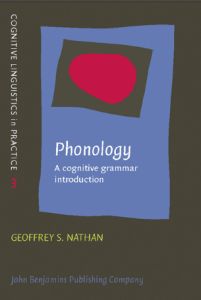Phonology: a cognitive grammar introduction
Geoffrey S. Nathan
Nathan, Geoffrey S.;
Phonology: a cognitive grammar introduction
John Benjamins Pub. Co., 2008, 171 pages
ISBN 9027219087, 9789027219084
topics: | linguistics | phonology
All spoken human languages make all (or virtually all) their words with combinations of consonants and vowels, and all (or virtually all) languages group those sounds into units called syllables, and generally, group the syllables into larger groups called feet. These constitute universal aspects of phonology, although the reader will notice hedges even within these statements.
[some languages allow greater complexity in their syllables.] the English word strengths is one of the most complex syllables in the world (p.1)
hawaiian - only permit syllables consisting of a single consonant followed by a single vowel. [also japanese?]
Similarly, some languages use enormous numbers of different sounds (some have as many as seventy) while other languages get by with tiny numbers (one language has only 13). There are enormous numbers of possible combinations of sounds, but in fact, languages tend to use a small common set over and over, and rare sounds are rare because only a few languages use them.
Phonetics vs Phonology
Phonetics : deals with all the possible human speech sounds – it is an inventory of possibilities, as defined by the human vocal apparatus, or the human perceptual system. Phonetics deals with what kinds of sounds humans can make. Phonology : what languages do with those sounds – how they select certain sounds, how those sounds are fitted into their environments, and how they are constructed into larger and larger units, such as syllables, feet, words and so on.
Roman Jakobson and Rule-based Phonology
a refugee from Nazi-occupied Prague, Roman Jakobson, who eventually ended up at Harvard University, across the river from MIT, had a significant influence on the development of the Generative version of phonology, even though Jakobson was himself one of the last living members of the original Prague School. Morris Halle and, to a certain extent, Noam Chomsky himself, with the collaboration (without, incidentally, the complete approval of Jakobson) developed the branch of phonology that could be roughly characterized as Generative Phonology, the theoretical framework that dominates most modern phonological theory. The Generative Phonology paradigm began with the idea that all variations in the pronunciation of a morpheme (not only the allophones, but even phonemic variants, such as the /k/ ~ /s/ alternation between electric and electricity could be accounted for by positing a single underlying form, and deriving all variations through the application of phonological rules which systematically changed the features of the phonemes involved. While this general view has remained essentially the same over the past (roughly) forty years, pieces of the theory have gone in a number of different directions. Chapter 10 will discuss the current state of the theory. p.5
amitabha mukerjee (mukerjee [at-symbol] gmail) 2013 Aug 13
